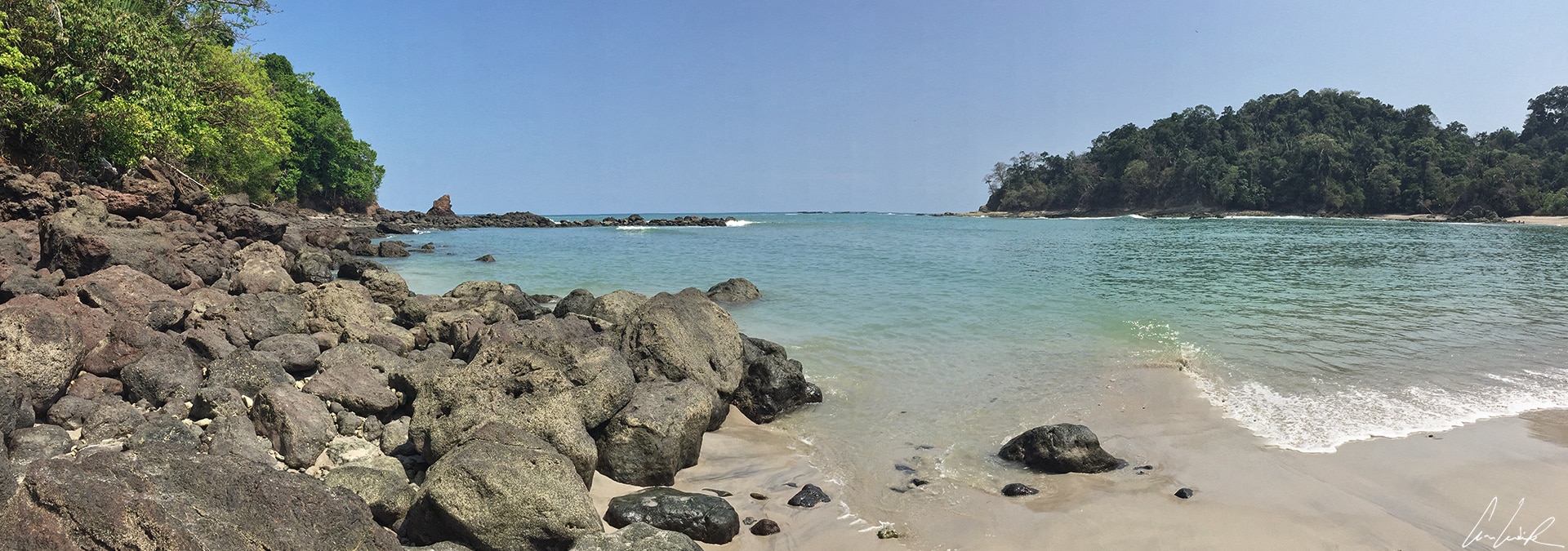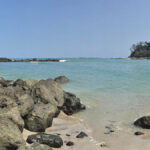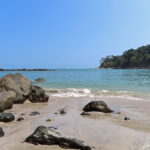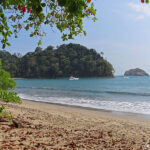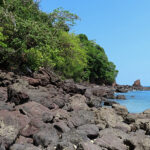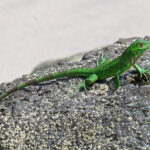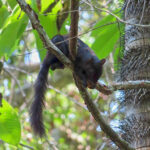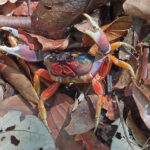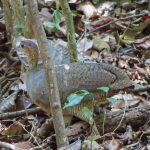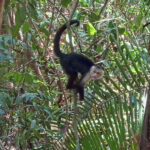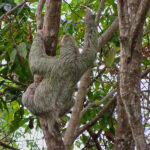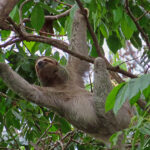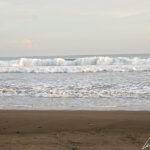The Parque Nacional Manuel Antonio is the smallest national park in Costa Rica. It lies on the Pacific coast, about 82 miles from the capital San José, and just south of Quepos. It is the most visited park in Costa Rica, was established in 1972 as a national park, and covers 7.66 square miles. It is a land and sea paradise. It is full of natural wonders in dry and wet tropical forests, primary and secondary forests, lagoons, and four beaches suitable for swimming, exploring the seabed with masks and snorkeling, or simply taking walks on the beautiful white sand. In addition to this paradisiacal setting, there is an abundance of wildlife: iguanas, howler monkeys, capuchin monkeys, sloths, squirrel monkeys, and Halloween crabs.
Hiking the trails of Manuel Antonio National Park
Visiting Manuel Antonio National Park (Parque Nacional Manuel Antonio) is easy because the trails are well laid out and marked. The park has ten trails one can hike independently or with a guide.
- Sendero Elevado El Manglar (the mangrove trail)
- Sendero Catarata (the waterfall trail)
- Sendero Peresozo (Sloth Trail)
- Playa Gemelas Trail
- Sendero Puerto Escondido
- Sendero Congos
- Sendero Miradores (Mirador Trail)
- Sendero Playa Manuel Antonio
- Sendero Punta Catedral
- Sendero Playa Espadilla Sur
Since the park closes at 4 PM, I recommend arriving when it opens at 7 AM to have enough time to hike all the trails. However, no matter how many hikes you do, the advantage of this small park is that you will immediately feel immersed in the rainforest. The diversity of wildlife is unequaled, with 109 species of mammals and 184 species of birds. There is such a concentration of mammals, reptiles, birds, and other critters that you will inevitably come face to face with local fauna many times. But let us be honest, it’s easy to spot colorful crabs or a bunch of monkeys playing on the beach. However, it requires a trained eye to spot a sloth hanging motionless in the middle of the abundant vegetation. But, let us believe in our good stars and bet on the Sendero Peresozo… The trail is named after the sloth, so we should see one, right ?
The Manuel Antonio Park on the ocean side: Paradise beaches, fauna, and flora
The paradise beaches of Manuel Antonio Park
The Sendero Principal, also known as the « Camino Perezoso » (sloth path), is a 2.1 mile out and back trail. The trail ends with two beautiful beaches – « Playa Manuel Antonio » and « Playa Espadilla Sur » – both with turquoise water. You can extend your hike from these two beaches via the Sendero Punta Catedral (1 mile). The trail goes around the peninsula (a piece of land shaped like a whale’s tail) and offers beautiful ocean views. In the middle of the jungle, the path goes up and down around the peninsula on uneven terrain. Even if this path is next to the two most popular beaches of the park, few people do the hike–so much the better ! Manuel Antonio Park is a popular destination, and most visitors enjoy sunbathing on its magnificent white sandy beaches.

The Playa Manuel Antonio
Playa Manuel Antonio is the most popular beach in the park: a cove with turquoise water and soft white sand, a tropical paradise. You can enjoy a lazy day with a good mystery book under the shade of the almond trees, or, If you’re looking for peace and quiet, « alone on the sand, eyes on the water », you can opt for the « neighboring » beach, Playa Espadilla Sur, located on the north side of Punta Catedral. If the beach is not as picturesque as Playa Manuel Antonio, it remains stunning and is usually almost deserted… On the black rocks, reptiles (lizards and iguanas) are basking in the sun ! Finally, if you want to play the Robinsons, opt for Playa Gemelas, the jewel of the park: a small quiet cove a little further from the main paths.

The Playa Espadilla Sur in Manuel Antonio Park
The beaches of Manuel Antonio Park in terms of fauna and flora: danger is waiting !
Keep an eye on your backpacks, no matter which beach you choose for an invigorating swim in the crystal clear water. The Mapache raccoon, a little masked thief, is not afraid of anything. He opens your bag, steals your lunch at lightning speed, and then takes off like a rocket… I understand better why one of the star members of the Guardians of the Galaxy is called « Rocket Raccoon »… Another danger on the beach is El árbol de Manzanillo or Manchineel tree (Hippoman of mancinella.) The name, taken from the Spanish Manzanilla (Little Apple), comes from the resemblance of its fruits and leaves to those of an apple tree. There is no better and more welcoming place than under a small apple tree 16 to 32 feet high with small apples throwing off a pleasant fragrance… But, the manzanillo, also nicknamed « manzanilla de la Muerte » (little apple of death), is one of the most toxic trees in the world. Although it owes its fame mainly to its poisonous fruit, the milky-white sap contains numerous toxins. It is present in every part of the tree, including bark, leaves, and flowers. Simple contact with its bark can cause severe blistering and burning sensations on the skin. It is even said that some Caribbean tribes tied their captives to the tree and then waited for rain. The sap, filled with toxins and highly soluble in water, would then spread over the captives’ bodies causing blisters, burns, and intense irritation. So, are you still up for a little nap in the shade of the manzanillo tree? Who would have thought that relaxing on the beach could be so dangerous ?
Manuel Antonio Park and marine life
With a land area of only 7.66 square miles, this park may seem small at first sight, but the Parque Nacional Manuel Antonio covers marine territory of 212.36 square miles. Unfortunately, we did not have the chance to see the innumerable species of marine fauna. On a boat trip in the reserve, it is indeed possible to see humpback whales during the season (from December to April), spotted dolphins, bottlenose dolphins, and sea turtles.
Manuel Antonio Park: Animal watching
Heading inland and into the jungle, the Sendero Miradores trail (about 1 mile) will take you to a beautiful lookout point on a bluff overlooking the majestic Punta Serrucho, a narrow strip of steep coastline that juts out into the ocean. Its name, « Saw Point », describes its jagged and irregular shape caused by tectonic movements. On this side road, we have discovered a rich forest swarming with life…
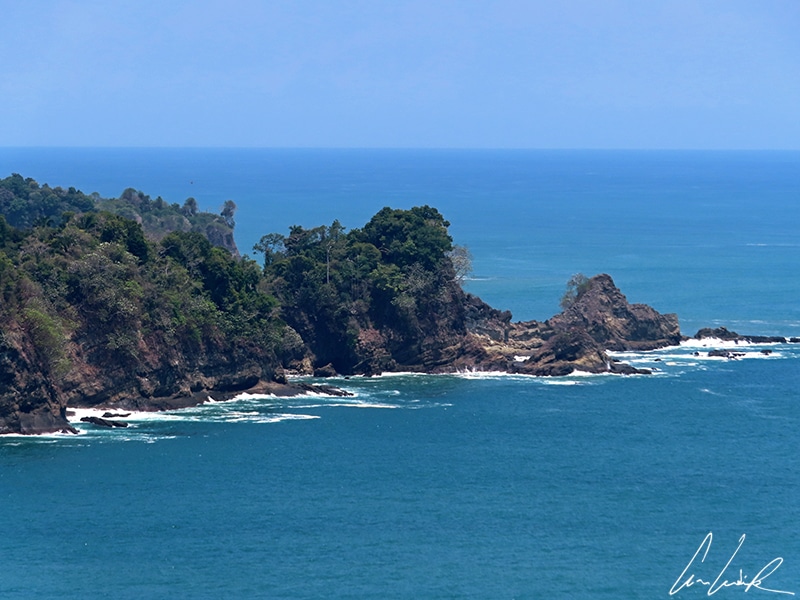
The Punta Serrucho, a narrow strip of steep coastline
« I walked with my eyes on the ground
You always had your nose in the air
That’s how we met. »
(Les chemins de traverse by Francis Cabrel, a French singer)
A festival of animals on the ground and in the air…
The rustle of leaves makes us raise our eyes. On a branch, a squirrel enjoys its meal. Then an astonishing and frightening call resounds in the tropical forest. It is a tribe of howler monkeys jumping from tree to tree. How do the monkeys get so high up in the trees ? Simply by using a climbing plant known as the « Escalera de Mono » (Bauhinia Ungulata) that grows in moist, shady places. Like a ladder, this plant entangles itself to form bridges at the top of trees used by monkeys, among others. But you should not keep your nose constantly in the air because the show is also close to the ground. Hundreds of Halloween crabs (Gecarcinus Quadratus) small colorful land crabs that move backwards snapping their purple claws if you approach them too closely… Moreover, the Great Tinamou(Tinamus major) does not stick around too long and leaves by walking silently. It moves away like a person sneaking away on tiptoe.

The Halloween Crab or Halloween Moon Crab
The white-headed capuchin: the most intelligent monkey in Costa Rica
On the Sendero Miradores, we cross paths with a dozen white-headed capuchin monkeys (Cebus capucinus,) who jump from branch to branch and climb trees. A simply magical show ! In Spanish they are called « maicero cariblanco » (white-faced corn eater) because of their pronounced taste for corn ! They are also called monkey, monk capuchin, white-faced sapajou, or simply capuchin. The male weighs up to 8.8 pounds, and the head and body length is between 13 and 18 inches; the female is smaller, weighing only up to 6.6 pounds and measuring about 13 inches. Its black coat is reminiscent of the cowls of the Capuchin friars, and the fact that the black coat stops at the level of their pale pink face with rare white hairs reinforces the visual effect of the hood.

A white-headed capuchin monkey in Manuel Antonio Park
The white-faced capuchin is remarkably intelligent. The weight of its brain, around 80 grams, even rivals (proportionally, of course) that of the human brain. The capuchin monkey can carve pieces of wood to make a tool to flush out insects or any other prey. He also uses stones, carefully selected for their sharpness, to peel edible fruit or sometimes to shell his prey. Finally, he knows about the curative virtues of plants, regularly rubbing his coat with the pulp of certain fruits to get rid of parasites and/or protect his skin as with a moisturizing lotion.

A Three-toed sloth in Manuel Antonio Park
Bradypus tridactylus, Sloth’s king of Costa Rica
As lovers of small creatures, we watched for an extended period the phlegmatic ascent of the three-toed sloth or brown-throated sloth (perezoso in Spanish). Slowly but surely, could be the motto of this mammal. The three-toed sloth moves at an average speed of 0.15mph… the world’s slowest mammal. The three-toed sloth is about 18 inches in length and weighs 8-10 pounds. Another unique characteristic of the sloth is the slowness of its metabolism, due to a small heart and low pulse it cannot self-regulate its body temperature. They rely on solar energy to regulate their internal temperature, which varies between 73.4°F and 89.6°F. Because of their slow metabolism, they need to sunbathe to maintain their body temperature. Moreover, did you know that this strange animal rarely moves from the tree where it was born? It turns out that 86% of sloths live on the same branch all their lives !
« By my tree,
I lived happily,
I should never have left my tree…
By my tree,
I lived happily,
I should never have taken my eyes off it…»
(By Georges Brassens, By my tree)
The sloth is phyllophagous or folivores, feeding exclusively on leaves. It has no incisor or canine teeth only 18 rootless molars, which are mobile thereby greatly facilitating the chewing of the tough leaves it feeds on. The sloth is arboreal with a body adapted to hang by its limbs using its large curved and parallel claws each about two inches long. The claws’ design allows the sloth to grasp branches and move on the treetops. They spend most of their life hanging comfortably motionless or slowly moving from branch-to-branch upside down. It uses its powerful and curved claws like hooks. This quasi-permanent position of the “hanging pig” caused the displacement of certain organs, such as the liver and the stomach, to adapt to the permanent pressure exerted by gravity on its abdomen. The digestive system is also extremely slow and linked to its slow metabolism. It takes two weeks for a sloth to digest one meal. But, once a week, the sloth must leave the tree canopy’s comfort and start a slow journey to the ground to urinate and defecate. Their large claws help them to move from branch to branch, but it make it very difficult to move on the ground, rendering them vulnerable to predators…
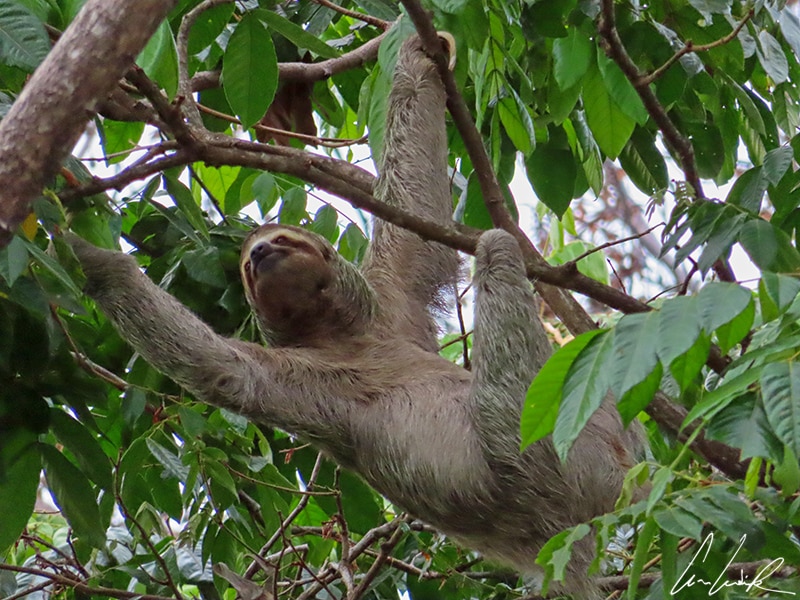
The three-toed sloth moves at an average speed of 0.15mph !
The sloth also has a strong immune system. It can regenerate its body after serious wounds: flesh, skin, and hair grow back identically as if nothing had happened! If scientists once considered this faculty a gift of regeneration (similar to the salamander,) we know today that the sloth has an incredibly efficient healing system. Its direct ancestor, the mylodon had the ability to heal from almost everything thereby earning its reputation for invincibility. Another disturbing common point is that the mylodon’s coat turned green over time, which gave rise to the legend of the « living tree » that eventually merged with the forest. The sloth’s fur is a living and breathing home for thousands of parasites (beetles, butterflies, and moths) but also cyanobacteria. These chlorophyll algae growing in the long coarse hairs give a greenish color. The coat has greener reflections the older a sloth gets… The algae play the role of camouflage among the tree leaves. Therefore, we can theoretically estimate a sloth’s age by looking at the amount of green in its coat.
Manuel Antonio Park, a hike between mangrove and tropical forest
Mangrove, one of the most productive ecosystems on the planet
Speaking of « living tree », the flora of Manuel Antonio Park is also worth a look ! The park is home to a beautiful primary rainforest with the emblematic Ceiba and the rain tree, complemented by 12 hectares of mangrove. The Ceiba can grow up to 230 feet tall, with a straight trunk and impressive buttress roots. The mangrove supports sustainable marine ecosystems and plays a vital role for many species of local and migratory birds. The roots of mangrove trees, called « Buttress roots », protect and feed many aquatic species, including fish, crustaceans, and mollusks which it protects from severe weather. The mangrove fertilizes the lagoons and promotes phytoplankton. If you still have doubts, you should know that the mangrove is one of the most productive ecosystems of biomass on our planet. Humans get much wealth from it, like mangrove wood and many plants for medicine, as well as fish and shellfish. However, if the mangrove is one of the most productive ecosystems it is also one of the most threatened ones. Mangrove forests are even more endangered than tropical forests and coral reefs! Mangrove decrease due to human activity. The loss rate is estimated at 0.16%, and per-country rates are as high as 0.70%. If urbanization is the main factor in its disappearance, shrimp farms that have developed worldwide since the 80s are also a real menace.
« In nature, nothing is perfect, and everything is perfect. Trees can be contorted, bent in weird ways, and they’re still beautiful ».
(Alice Walker, writer, and activist, author of « The Color Purple »)
Finding the Viscoyol palms and the Quassia in the rainforest
The Viscoyol palms are another curiosity of Manuel Antonio Park. Impossible to climb on this palm tree measuring from 6 to 33 feet tall and covered with very fine and rigid spines like needles. A group of Viscoyal palms forms a nearly impenetrable barrier. But some small, clever, courageous animals, like the white-faced monkeys and the titi monkeys, dare to sneak into its thorny trunk in search of a reward: clusters of juicy fruits, purple or blackish when ripe similar to grapes.
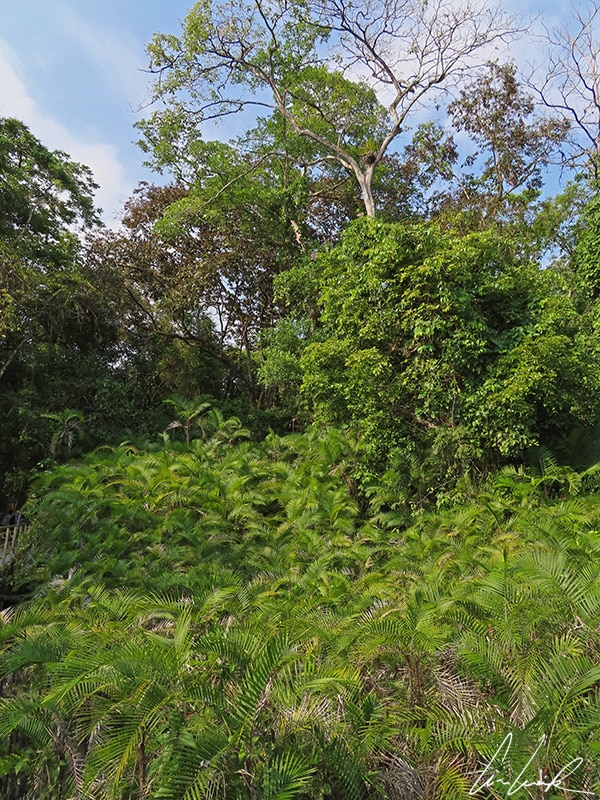
The Viscoyol palms, another curiosity of Manuel Antonio Park
Finally, Manuel Antonio Park is also home to the Quassia, known under its botanical name Quassia amara. It is also known as Bitter Quassia or Bitter Wood. The Quassia is an attractive small evergreen flowering shrub. It grows between 13 and 20 feet tall. The flower is bright red on the outside and white inside. The shrub is sought after by various industries, mainly to extract quassin, considered the bitterest substance on earth. Amara means « bitter » in Latin. The plant is used in traditional medicine to reduce fever. It is said that Quassia tea is so bitter that it would make blood undrinkable for mosquitoes! It is also a natural insecticide…

Sunset at Playa Palo Seco
The Playa Palo Seco: Pacific ocean and sand as far as the eye can see
Listening one last time to the sound of the waves, smelling the spray, the iodized air, the sight of the blue ocean, the sand between your toes… Would the ocean act as mental therapy ? We could stay in front of this display for hours, facing the trade winds and the setting sun. Let us enjoy this final evening in Costa Rica at the Playa Palo Seco, about 45 minutes’ drive west of Quepos. Playa Palo Seco is an unspoiled beach surrounded by tropical vegetation that stretches nearly 8 miles with sand as far as the eye can see and makes our last evening unforgettable…
Pura Vida !
Find more on Costa Rica
- Explore the cloud tropical forests of Costa Rica
- Costa Rica: A Vast Reservoir of Biodiversity
- Arenal Volcano National Park, a natural wonder
- Fauna and flora of the Arenal Volcano National Park
- Tenorio Volcano National Park, the most wonderful !
- The Caño Negro Refuge: Pointed teeth and Feathers along the Water
- The head in the clouds in the Reserve of Monteverde
- Exploring the Costa Rican Pacific coast: the Carara National Park
